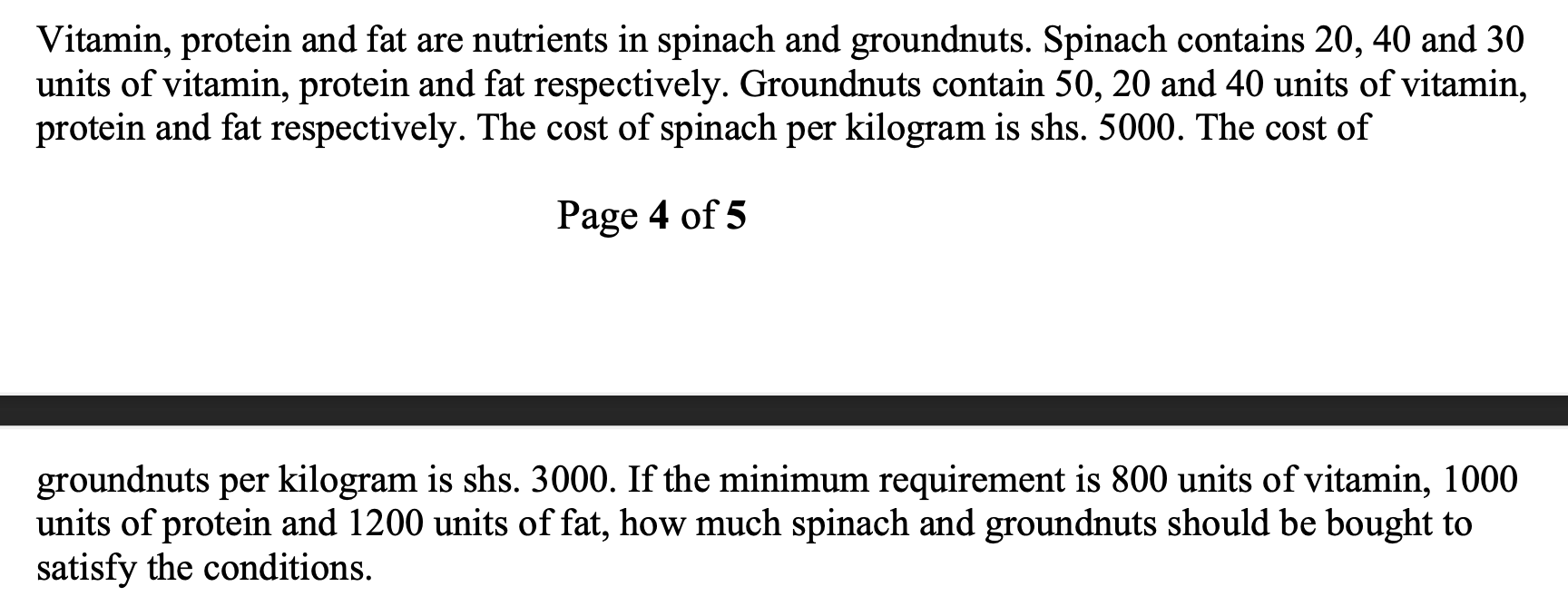Vitamin, protein and fat are nutrients in spinach and groundnuts. Spinach contains 20, 40 and 30 units of vitamin, protein and fat respectively. Groundnuts contain 50, 20 and 40 un... Vitamin, protein and fat are nutrients in spinach and groundnuts. Spinach contains 20, 40 and 30 units of vitamin, protein and fat respectively. Groundnuts contain 50, 20 and 40 units of vitamin, protein and fat respectively. The cost of spinach per kilogram is shs. 5000. The cost of groundnuts per kilogram is shs. 3000. If the minimum requirement is 800 units of vitamin, 1000 units of protein and 1200 units of fat, how much spinach and groundnuts should be bought to satisfy the conditions?

Understand the Problem
The question is asking to determine the quantity of spinach and groundnuts, given their nutritional content and cost per kilogram, to meet specific minimum requirements for vitamin, protein, and fat. This is a linear programming problem.
Answer
Buy $21.25$ kg of spinach and $7.5$ kg of groundnuts.
Answer for screen readers
The minimum cost is achieved when $x = 21.25$ kg of spinach and $y = 7.5$ kg of groundnuts are bought.
Steps to Solve
- Define variables
Let $x$ be the amount of spinach in kilograms and $y$ be the amount of groundnuts in kilograms.
- Formulate the objective function
The objective is to minimize the cost, which is given by: $$C = 5000x + 3000y$$
- Formulate the constraints
Based on the minimum requirements for vitamin, protein, and fat, we have the following constraints: Vitamin: $20x + 50y \ge 800$ Protein: $40x + 20y \ge 1000$ Fat: $30x + 40y \ge 1200$ Also, $x \ge 0$ and $y \ge 0$ since we cannot have negative amounts of spinach or groundnuts.
- Simplify the constraints
Simplify the inequalities: Vitamin: $2x + 5y \ge 80$ Protein: $2x + y \ge 50$ Fat: $3x + 4y \ge 120$
- Solve the system of inequalities graphically or using linear programming techniques
First, find the intersection of $2x + 5y = 80$ and $2x + y = 50$: Subtract the second equation from the first to get $4y = 30$, so $y = 7.5$. Then, $2x + 7.5 = 50$, so $2x = 42.5$, and $x = 21.25$. Intersection point: $(21.25, 7.5)$
Next, find the intersection of $2x + 5y = 80$ and $3x + 4y = 120$: Multiply the first equation by 3 and the second by 2: $6x + 15y = 240$ $6x + 8y = 240$ Subtract the second equation from the first to get $7y = 0$, so $y = 0$. Then, $2x = 80$, so $x = 40$. Intersection point: $(40, 0)$
Next, find the intersection of $2x + y = 50$ and $3x + 4y = 120$: Multiply the first equation by 4 to get $8x + 4y = 200$ Subtract the third equation from this to get $5x = 80$, so $x = 16$. Then, $2(16) + y = 50$, so $32 + y = 50$, and $y = 18$. Intersection point: $(16, 18)$
- Evaluate the objective function at the corner points of the feasible region
We need to consider the corner points of the feasible region. The corner points are $(16,18)$, $(40, 0)$, and $(21.25, 7.5)$.
Evaluate $C = 5000x + 3000y$ at these points: At $(16, 18)$: $C = 5000(16) + 3000(18) = 80000 + 54000 = 134000$ At $(40, 0)$: $C = 5000(40) + 3000(0) = 200000$ At $(21.25, 7.5)$: $C = 5000(21.25) + 3000(7.5) = 106250 + 22500 = 128750$
- Consider other intersection points
We must also check $x=0$ and $y=0$ intercepts implied by the constraints to determine which points give the absolute minimum.
If $x=0$:
$5y \ge 80 \implies y \ge 16$
$y \ge 50$
$4y \ge 120 \implies y \ge 30$
Therefore the $x=0$ intercept with the feasible region is $(0,50)$ giving a cost of $C=50*3000 = 150000$.
If $y=0$: $2x \ge 80 \implies x \ge 40$ $2x \ge 50 \implies x \ge 25$ $3x \ge 120 \implies x \ge 40$
Therefore the $y=0$ intercept with the feasible region is $(40,0)$ with a cost of $C = 40*5000 = 200000$.
- Determine the minimum cost
The minimum cost is 128750 at $(21.25, 7.5)$. Since we are likely dealing with physical quantities, we might want to consider integer solutions close to this point. However, without further constraints or information, we will take the non-integer solution as the optimum.
The minimum cost is achieved when $x = 21.25$ kg of spinach and $y = 7.5$ kg of groundnuts are bought.
More Information
The problem is a classical linear programming problem but with an additional caveat that a real world constraint like this can't have fractions of kilograms as outputs. However, the problem does not provide additional constraints so we are forced to assume fractional kilogram outputs are allowed.
Tips
A common mistake is not simplifying the constraint equations before solving, which can make the calculations more complex. Another mistake is failing to consider all intersection points of the constraints.
AI-generated content may contain errors. Please verify critical information